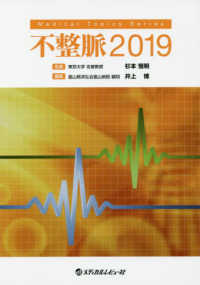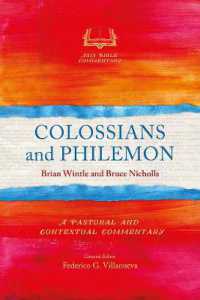- ホーム
- > 洋書
- > 英文書
- > Juvenile Grades 10-12
Full Description
Solidify learning and support achievement. This comprehensive and accessible Revision Guide is designed to develop exam confidence and build a firm foundation for further study. Consolidating all the examinable material in a digestible, student-friendly format, the Guide also offers a bank of practice material to concretely build assurance and understanding, helping students achieve their best. This edition is fully aligned to the Cambridge syllabus for finalexamination in 2019. A new edition for the latest Cambridge syllabus, for examination from 2020, will be available in 2018.
Contents
1. World population growth ; 2. Population variations and associated problems ; 3. The effect of migration and HIV/AIDS ; 4. Settlement hierarchy and pattern ; 5. Site, situation and growth of settlements ; 6. Urban land use ; 7. Problems of urban areas ; 8. Urbanisation and the environment ; 9. Theme 1: Exam-style questions ; 10. Plate tectonics ; 11. Volcanoes and earthquakes ; 12. Weathering ; 13. River processes (1) ; 14. River processes (2) ; 15. Marine erosion ; 16. Marine transportation and deposition ; 17. Coral reefs and coastal sand dunes ; 18. Weather and weather station recording instruments ; 19. Weather data calculations, graphs and diagrams ; 20. Clouds and weather hazards ; 21. Climate of tropical rainforest areas ; 22. Climate of desert areas ; 23. The tropical rainforest and tropical desert ecosystems ; 24. The natural environment and human activities (1) ; 25. The natural environment and human activities (2) ; 26. Theme 2: Exam-style questions ; 27. Agriculture and large-scale commercial farming ; 28. Small-scale subsistence farming and food shortages ; 29. Industrial systems ; 30. Tourism ; 31. Energy - oil, gas, coal, nuclear and fuel wood ; 32. Renewable energy and water supply ; 33. The need for sustainable development, resource conservation and management ; 34. The impact of pollution on the natural environment ; 35. Theme 3: Exam-style questions ; 36. Survey maps (topographic maps) ; 37. Physical features on survey maps: relief and drainage ; 38. Photographs, field sketches, data tables and graphs ; 39. Geographical skills: Exam-style questions ; 40. Coursework: planning investigations ; 41. Coursework: data collection ; 42. Coursework: presentation, analysis and evaluation ; 43. Coursework skills: Exam-style questions








